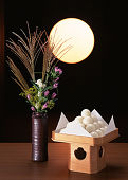Annual Events in Japan
September: Otsukimi
Otsukimi means enjoying the view of the moon. However, it also refers to the night of August 15th (Jugoya) on the old Japanese calendar.
The Jugoya moon is called the harvest moon and has long been known as a good time for admiring the moon. On this night, an altar is set up in a place where the moon is visible and offerings of dumplings, pampas grass, and potatoes are made. The custom of viewing the harvest moon came to the nobility of Japan from China during the Heian period and also spread to samurai and townspeople. Farmers knew the farming seasons through the waxing and waning of the moon. They were able to work in the fields until late at night thanks to the moonlight. The custom of Otsukimi took root out of gratitude to the moon. As a result, crops harvested during this period came to be associated with Imomeigetsu (the potato harvest festival) as well.
Otsukimi on the night of the 13th day of the lunar month
When we think of Otsukimi, Jugoya usually comes to mind. However, the moon on the 13th day of the 9th month of the old lunar calendar (Jusanya) is thought to be quite beautiful as well. The custom of viewing the moon on this day remains in many areas to this day. The practice of only viewing either Jugoya or Jusanya is called 'katatsukimi' and is to be avoided. Viewing both moons has long been considered auspicious. This did not begin in China but rather is an original Japanese custom. Jusanya is also known as 'Kurimeigetsu' or 'Mamemeigetsu' as Japanese chestnuts or green soybean are often given as offerings.
Why is the date for Otsukimi different each year?
Because Otsukimi is held according to the old Japanese calendar. Since the dates of the old Japanese calendar are decided according to the waxing and waning of the moon, the new moon becomes the first day of the month. The current western calendar uses a different system, so the date of the harvest moon differs each year. Also, the harvest moon isn't always a full moon.
The Legend of the Rabbit on the Moon

In Japan, people say that a rabbit lives on the moon and pounds rice cakes, but this was originally a myth from India. In every part of the world, there are myths and legends associated with the moon. In Japan, it's said that the dark parts of the surface of the moon resemble a rabbit pounding rice cakes. However, people of other nationalities or ethnic groups have a different way of looking at this pattern. For example, in Europe, it's the profile of a woman's face. In China, it's a crab or an alligator.
This year, 2011, Jugoya is on September 12nd, and Jusanya is on October 9th.
Enjoy gazing at the beautiful autumn moon while eating dumplings and singing.
This year, 2011, Jugoya is on September 12nd, and Jusanya is on October 9th.
Enjoy gazing at the beautiful autumn moon while eating dumplings and singing.
"The Rabbit Song"
Rabbit, rabbit, what are looking at?
Hop, look at the Jugoya harvest moon, hop
Rabbit, rabbit, what are looking at?
Hop, look at the Jugoya harvest moon, hop





 Japan
Japan 한국어
한국어 简体字
简体字 繁体字
繁体字 English
English













